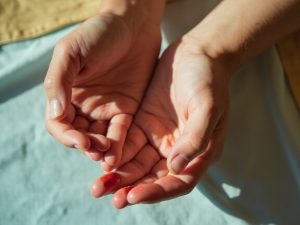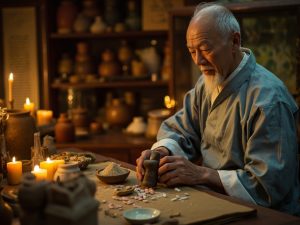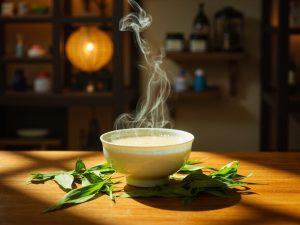Table of Contents
ToggleDa Huang Mu Dan Tang – Nan Kaiyang
Author: Nan Kaiyang Editor: Gu Yuxi Translator: Gu Yuxi
Article
Synopsis from Jingui Yaolue (Prescriptions from the Golden Cabinet), Chapter 18: Sores, Carbuncles, Intestinal Carbuncles, and Spreading Sores
4.In cases of intestinal carbuncle, there is swelling and induration in the lower abdomen, which, when pressed, causes pain like strangury. Urination is normal, and there is intermittent fever, spontaneous sweating, and aversion to cold. If the pulse is slow and tight, pus has not yet formed; it can be purgated, and there should be blood. If the pulse is surging and rapid, pus has already formed; it should not be purgated. Da Huang Mu Dan Tang is indicated.
Formula:
- Da Huang (Rhubarb): 20g
- Mu Dan Pi (Cortex Moutan): 5g
- Tao Ren (Peach Kernel): 20g
- Dong Gua Zi (Winter Melon Seed): 35-50g
- Mang Xiao (Glauber’s Salt): 10g
Interpretation
Da Huang Mu Dan Tang possesses the actions of clearing heat, dispelling blood stasis, resolving masses, and reducing swelling. It is particularly effective for the damp-heat accumulation and toxins in the initial stage of intestinal carbuncle. Throughout history, physicians have considered it the primary formula for treating intestinal carbuncle. However, there has been a discussion regarding whether Da Huang Mu Dan Tang can be used after pus has formed in intestinal carbuncle. Let’s discuss this here:
I.
Master Zhang Zhongjing stated: “If pus has not yet formed, it can be purgated, and there should be blood.” This means that in the initial stage of intestinal carbuncle, this formula can be used to purge blood stasis and damp-heat toxins. Later, regarding the method of administration, it says: “Take it in one dose; if there is pus, it will be discharged; if there is no pus, blood will be discharged.” This statement indicates that this formula can be used both in the initial stage of intestinal carbuncle before pus has formed and during the period when intestinal carbuncle is suppurating. If there is pus, the pus will be discharged; if there is no pus, blood will be discharged. Damp-heat and stagnant toxins can all be expelled with it. This statement echoes and complements the previous statement, “it can be purgated, and there should be blood.” It is clear that the statement after the formula is for a reason and not superfluous. However, are “if there is pus, it will be discharged” and “if pus has already formed” not contradictory? This is precisely the purpose of this discussion.
II.
If we follow ancient grammar, “In cases of intestinal carbuncle… there should be blood” is the pre-posed object of the clause “Da Huang Mu Dan Tang is indicated.” “Da Huang Mu Dan Tang is indicated” should come after “…there should be blood.” In this way, it can be seen that Master Zhang Zhongjing’s text primarily elaborates on the optimal indications for this formula. The subsequent text, “If the pulse is surging and rapid, pus has already formed; it should not be purgated,” does not refer to “Da Huang Mu Dan Tang is indicated.” It does not mean that this formula cannot be used after suppuration; rather, it expounds on the treatment principle that strong purging is not allowed after intestinal carbuncle has suppurated. Da Huang Mu Dan Tang is not a drastic purging agent like Xiao Cheng Qi Tang or Da Cheng Qi Tang for Yangming excess patterns. It is primarily used for intestinal carbuncle in its initial stage before suppuration. It is not that it cannot be used during the suppuration stage of intestinal carbuncle. Following this, it says: “if there is pus, it will be discharged; if there is no pus, blood will be discharged.” Looked at this way, there is no contradiction.
III.
Regarding these points, You Zaijing mentioned in Jingui Yaolue Xin Dian (A Heartfelt Guide to the Prescriptions from the Golden Cabinet): “Da Huang Mu Dan Tang can be used whether intestinal carbuncle has formed pus or not, hence it says ‘if there is pus, it will be discharged; if there is no pus, blood will be discharged’,” indicating approval for its use even with pus. Gao Xueshan believed: “‘It can be purgated or not’ does not refer to the Da Huang Mu Dan Tang mentioned later, but rather to Da Cheng Qi Tang, Tao He Cheng Qi Tang, or Di Dang Tang.” He also said, “Those who indicate Da Huang Mu Dan Tang… will have both solid heat and pus-blood removed.”
His opinion is that Master Zhang Zhongjing’s original text must be understood in context. The “not to be purgated” refers to Da Cheng Qi Tang and Tao He Cheng Qi Tang, not this formula. Therefore, interpreting the literal meaning as “Da Huang Mu Dan Tang cannot be used when pus has formed” is incorrect. Cao Yingfu, a contemporary renowned physician, also mentioned in his Jing Fang Shi Yan Lu (Records of Classical Formula Experiments): “After pus has formed, it is said it cannot be purgated. May I ask what is to be done with the pus? Will the pus turn back into blood? This is absolutely impossible.” This shows that not purging after pus has formed goes against common sense in Chinese medicine. Most importantly, while the rationale can be repeatedly explained, this formula is frequently used in clinical practice after pus has formed, which is the most convincing evidence. This formula is used in the initial stage of intestinal carbuncle. Regardless of whether there is pus or not, as long as it belongs to the pattern of heat toxin and blood stasis, it can be used, and its efficacy is certain. In clinical practice, using symptoms to verify texts and texts to verify symptoms is the core essence of classical formulas.
Disclaimer:
The experiences and insights shared above represent the author’s personal usage and understanding, and are provided for reference only as part of academic exchange. Please do not blindly replicate or apply them; any consequences arising from such actions are solely your responsibility. As individual constitutions vary, medication should be tailored accordingly. It is advisable to use such treatments under the guidance of a qualified physician. If you have additional experiences to share, comments and submissions are welcome.
If you appreciate my article, please give it a like.
If you are a generous and affluent individual, please consider making a donation!
Your recognition is my greatest motivation to continue writing—thank you very much!
USD Donation Button —
A RMB donation button is available below.
 微信赞赏
微信赞赏 支付宝赞赏
支付宝赞赏




